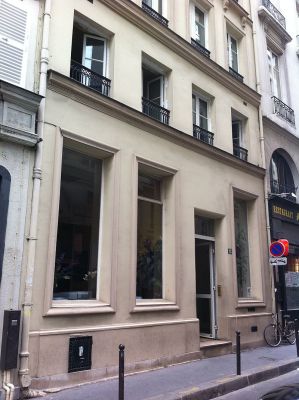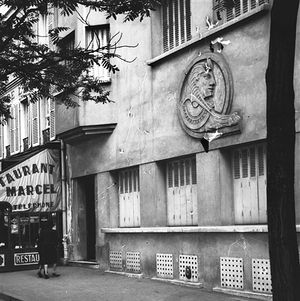Brothels in Paris
The authorities of medieval Paris attempted to confine prostitution to a particular district. Louis IX (1226–1270) designated nine streets in the Beaubourg Quartier where it would be permitted. In the early part of the 19th century, state-controlled legal brothels (then known as "maisons de tolérance" or "maisons closes") started to appear in several French cities. By law, they had to be run by a woman (typically a former prostitute), and their external appearance had to be discreet. The maisons were required to light a red lantern when they were open (from which is derived the term red-light district and the prostitutes were only permitted to leave the maisons on certain days and only if accompanied by its' head. By 1810, Paris alone had 180 officially approved brothels.
During the first half of the 20th century, some Paris brothels, such as le Chabanais and le Sphinx, were internationally known for the luxury they provided.
France outlawed brothels in 1946 after a campaign by Marthe Richard. At that time, there were 1,500 of them across the country, with 177 in Paris alone. The backlash against them was partly due to their wartime collaboration with the Germans during the occupation of France. The Germans had commandeered twenty-two Paris brothels for their exclusive use; some had made a great deal of money by catering to German officers and soldiers. One brothel in the Montmartre District of the French capital was part of an escape network for POWs and Allied airmen who were shot down.
Luxury brothels
 Main article: Le Chabanais
Main article: Le Chabanais
Le Chabanais was one of the best known and most luxurious brothels in Paris, operating near the Louvre at 12 rue Chabanais from 1878 until 1946, when brothels were outlawed in France. It was founded by the Irish-born Madame Kelly, who was closely acquainted with several members at the Jockey Club de Paris. Among the habitués were Edward VII, Prince of Wales; Toulouse-Lautrec; Cary Grant; Humphrey Bogart, Mae West, and diplomatic guests of the French government.
The brothel, famous enough to warrant mentioning in the 7-volume Nouveau Larousse illustré encyclopaedia of 1904, was founded by the Irish-born Madame Kelly (real name - Alexandrine Joannet (or possibly Jouannet)), who was closely associated with several members at the prestigious Jockey Club de Paris. She sold shares in the profitable business to wealthy anonymous investors. The total cost of the establishment was reported to be the exorbitant sum of 1.7 million francs. The entrance hall was designed as a bare stone cave; the bedrooms were lavishly decorated, many in their own style: Moorish, Hindu, Japanese, Pompeii and Louis XVI. The Japanese room won a design prize at the 1900 World Fair in Paris. Madame Kelly died in 1899.
La Fleur Blanche
 Main article: La Fleur Blanche
Main article: La Fleur Blanche
La Fleur blanche was a famous maison close (brothel) in the city of Paris, located at 6 rue des Moulins in the 1st arrondissement of Paris. The property was also known as rue des Moulins and was famous for its torture room.
It was one of the most luxurious brothels in Paris. Its clientele included kings, crown princes, members of the aristocracy, and numerous heads of state.
The brothel was known for its extremely lavish bedrooms, each one having its own theme, for example, one was in a Moorish style, and another was ducal.
La Fleur Blanche was notably frequented by Toulouse-Lautrec (where he had a room, according to legend); he was called The Coffee Pot by the girls due to his small size.
The artist painted Griserie the beautiful stranger on a wall in the brothel. The brothel also gave inspiration for forty paintings and drawings, including Mills Street Fair (1894), The Sofa (1894), and Ces dames au réfectoire (1893).
L'Étoile de Kléber
 Main article: L'Étoile de Kléber
Main article: L'Étoile de Kléber
L'Étoile de Kléber was a maison close (brothel) in Paris. It obtained notoriety for continuing to run after the 1946 Loi Marthe Richard ban on brothels. It continued its operations for a while in secret. It was located at 4 Rue Paul-Valéry in the 16th arrondissement of Paris. It was founded and managed by Aline Soccodato, known as Madame Billy. Its clients included King Farouk and Maurice Chevalier.
During the German occupation, customers were officers of the Wehrmacht (German army) and of the Carlingue (French Gestapo), whose headquarters were only a short distance away at 93 Rue Lauriston, but this was an advantage since they had meat, caviar, and champagne which was transferred to L'Étoile's kitchen.
After the war, the occupation clientele changed, and there were more and more allied officers in the L'Étoile de Kléber. The Soccodatos had hidden escaped British military, resistance fighters, and Jews in the war and forwarded encrypted messages to the French Resistance.
One-Two-Two
 Main article: One-Two-Two
Main article: One-Two-Two
The One-Two-Two was one of the most luxurious and illustrious brothels of Paris in the 1930s and 1940s. The name was taken from the address 122 Rue de Provence, 8th arrondissement of Paris. The numbers were translated into English to ensure that foreign tourists would be able to find the brothel and as a password for French people.
The One-Two-Two was opened in 1924 by Marcel Jamet and his first wife Fernande, who called herself Doriane, a former woman of another brothel in Paris, Le Chabanais. Doriane, through her husband, acquired 122 Rue de Provence. At first, she employed only three women.
The building had twenty-two themed rooms. Forty to sixty-five prostitutes worked for 300 clients per day. It was open from 4:00 pm to 4:00 am. The establishment girls had four sex sessions a day at twenty francs each, excluding tips, and two sessions on Sunday. There was also a bar, a refectory for girls, and a doctor's office.
Raspoutine
Once a luxury brothel, frequented Gainsbourg, at 58 rue de Bassano, it is now a nightclub. Taking its name from the famous mystic Grigori Rasputin of Russia, it had rich Russian-Baroque decorations designed by the artist Erté, who also designed some of costumes of the Folies Bergères. It is listed as a Historic Monument.
Le Sphinx
 Main article: Le Sphinx
Main article: Le Sphinx
Le Sphinx was a maison close (brothel) in Paris in the 1930s and 1940s. Along with the "Le Chabanais" and "One-Two-Two" it was considered one of the most luxurious and famous Parisian brothels. It was the first luxury brothel and opened on the left bank of the Seine. Because of its location in the triangle of "literary" cafés (La Coupole, Rotonda and the Cafe du Dome) in Montparnasse, was popular with literary and artistic bohemians.
"Le Sphinx" was not a brothel in the usual sense of the word. The main attraction in it was not in the richly decorated rooms with air conditioning and nickel-plated beds but in the dance bar on the first floor, where you could also get a haircut or a pedicure. There were normally 15 girls, selected by the madame, in the bar. However, no one forced them to have sex with the clients; the girl decided themselves. Some Sphinx workers never engaged in prostitution, but worked as "hostesses", receiving commission from drinks consumed by guests. This feature of the Sphinx probably made it so popular among French bohemians of that time.
Maisons d'abattage
Nicknamed maisons d'abattage (“slaughterhouses”), these brothels catered to the masses. The clients took numbered tickets and lined up for their turn. The prostitutes would service 60 to 100 clients a day. The girls were often abused by the clients or by the Brigade de répression du proxénétisme, whose job was to find unlicensed prostitutes and brothels.
Le Fourcy
 Main article: Le Fourcy
Main article: Le Fourcy
Le Fourcy was the most famous mass brothel of Paris, a so-called Maison d'abattage. It was located in the Saint-Paul district in the 4th arrondissement of Paris at 10 rue de Fourcy and was notorious for treating its women very badly. In his book Le Petit Simonin, novelist Albert Simonin wrote: "The Fourcy in the district of Saint-Paul, the most famous of the Paris slaughterhouses, demanded 5.50 francs per session. "Five francs per lady and room," as if it were a chorus's chorus, who goes to the room? "The ten sous (fifty centimes), which were asked for as a supplement to the five francs, is not a tip, but a tariff for the towel attracted so many customers on working days that some ladies who were not too bad were anything but unemployed and able to cope with seventy sessions."
Lanterne Verte
 Main article: Lanterne Verte
Main article: Lanterne Verte
The Lanterne Verte (Fr. Green Lantern) was located on the corner of Rue de Chartres and Rue de la Goutte d'Or in the Goutte d'Or district in the 18th arrondissement of Paris and was one of the more moderate brothels of Paris. The unusual thing about this brothel was that it had no rooms. The writer and poet Sylvain Bonmariage describes it in his book Gagneuses: "The Lanterne Verte was a brothel; it was declared as such, and in its large hall, furnished as a cafe, naked girls served the offer of the house. A schoppen (bottle) of white wine cost a franc, and whoever wanted to fuck with the girls or wank one, the waitress was paid forty sous. Everything happened on a bench or chair of the establishment: there were no rooms. Customers entering were usually surprised at two or three pairs who were just in full swing. This Lanterne Verte was a prosperous business; each waitress served thirty customers on average between twelve and five o'clock in the morning, bringing her sixty francs".
In contrast to other brothels of Paris, such as Le Fourcy, the prostitutes were treated more justly there.
Le Moulin Galant
In the rue de Fourcy was Le Moulin Galant; it was reserved for the homeless. The brothel consisted of two parts: The Deputies Chamber, where the cost was 10 francs for 5 minutes, and the Senate where the charge was 15 francs.
Le Moulin Galant was also known as Le Fourcaga.
Gay brothels
Hotel Marigny
Famed novelist Marcel Proust was a frequent patron of gay brothels and invested in two of Paris' specialist maisons closes for gay men. One of these was l'hôtel Marigny, established in 1917 at 11 rue de l'Arcade in the 2nd arrondissement of Paris. Proust would come by under an assumed name almost every day." He made a deal with the brothel managers to spy on the clients through a small window. These experiences would later appear in his writing.
Premises suspected of being gay brothels, including the Hotel Marigny, were however subject to frequent police raids by the groupe des homos, a special police squad formed by Napoleon III.
Hotel Marigny was notorious for supplying minors for adult men. During a raid in 1918 the police arrested 24 underage boys and 24 adult males, including Proust.

